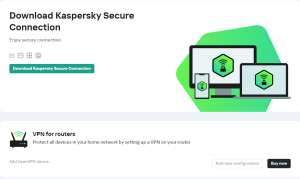-
Posts
474 -
Joined
-
Last visited
Reputation
585 ExcellentRecent Profile Visitors
1961 profile views
-
This is not new for your information has not been created by Kaspersky. It is a Compulsory requirement in India for purchase online by Government in India for Tax reasons on Online Purchases. Thank you
-

MS Teams only works when i disable my Kaspersky
KarDip replied to Hmbm's topic in Kaspersky Total Security
Hello @Hmbm as well as above posts. Try disable IPv6 also check your DNS Server. Take a look Team Viewer Issues below. https://www.helpwire.app/blog/teamviewer-not-working/#Allow_Full_Access_To_TeamViewer Please let us know how you go. Thank you. -

After an update today, many SSL connections are silently blocked.
KarDip replied to ice70's topic in Kaspersky Total Security
Hello @ice70 As well as above post. Also if you do not want to update to Kaspersky Plus Try this. In the main window of your Kaspersky application, click . Go to Security settings and click Network settings. Click Trusted addresses → Add. Specify the website address that was displayed in the certificate warning message. Select the Active status and click Add. Click Save. Click Save → Confirm https://support.kaspersky.com/common/safemoney/12489#block8 https://support.kaspersky.com/KWTS/6.1/en-US/186340.htm https://support.kaspersky.com/KWTS/6.1/en-US/186279.htm https://support.kaspersky.com/KWTS/6.1/en-US/186292.htm If none of the above helps follow Berny's update to Kaspersky Plus. Thank you -
Hello @ Imyaroy Please try again from this Kaspersky Standard Update download Link. https://www.kaspersky.com.au/downloads#update-product Or download Full Version here>> https://www.kaspersky.com.au/downloads/standard If that dos not work "uninstall kaspersky" reboot your computer then reinstall again from Your My Kaspersky Portal. Thank you
-
Hell @Ali A. Al-Gamal Hello! It seems like you want to create a policy in Kaspersky Security Center version 14 to disable Command Prompt (CMD) and PowerShell on the managed computers. Kaspersky Security Center is a management console for Kaspersky security software. To achieve your goal, you can follow these general steps: 1. **Open Kaspersky Security Center:** Log in to your Kaspersky Security Center console with administrative privileges. 2. **Create a New Policy:** Navigate to the "Policies" section and create a new policy or modify an existing one. 3. **Configure Application Control:** Application Control is a feature that allows you to manage which applications are allowed to run on managed computers. To disable CMD and PowerShell, follow these steps: a. In the policy settings, navigate to the "Application Control" section. b. Look for options related to executable control or application management. c. Add rules to block the execution of `cmd.exe` (Command Prompt) and `powershell.exe` (PowerShell) on managed computers. You'll need to provide the full path to these executables. 4. **Apply the Policy:** Once you've configured the policy to disable CMD and PowerShell, apply the policy to the relevant group of managed computers. 5. **Deploy the Policy:** The policy changes will need to be deployed to the managed computers. Depending on your Kaspersky Security Center configuration, this might happen automatically or require manual synchronization. Please note that the steps provided are based on general principles and may vary slightly based on the specific interface and options available in Kaspersky Security Center version 14. Always refer to the official documentation or consult with your IT team for accurate instructions tailored to your setup. Remember that disabling CMD and PowerShell can impact the functionality of your systems and applications. It's important to thoroughly test this policy in a controlled environment before applying it to production systems. Additionally, ensure you have a reliable backup and recovery plan in place in case any issues arise. Thank you
-
Hello @ARUNABHA BISWAS If you're experiencing issues with Kaspersky VPN not working properly in conjunction with Kaspersky Total Security, here are some steps you can take to troubleshoot the problem: 1. **Update Software**: Ensure that both Kaspersky Total Security and the Kaspersky VPN software are up to date. Outdated software can sometimes lead to compatibility issues. 2. **Check Settings**: Make sure that the settings within Kaspersky Total Security are not conflicting with the VPN. Double-check any firewall or network-related settings that could be affecting the VPN's functionality. 3. **Temporary Disable Total Security**: Temporarily disable Kaspersky Total Security and then try using the VPN. This can help determine if the issue is related to a conflict between the two programs. Remember to re-enable Total Security afterward. 4. **Exclusions**: Add the Kaspersky VPN executable or related processes to the exclusion list in Kaspersky Total Security. This can prevent Total Security from interfering with the VPN's operation. 5. **Contact Kaspersky Support**: If none of the above steps work, it's best to reach out to Kaspersky's customer support. They can provide specific guidance and troubleshoot the issue based on your setup and configuration. Remember that software compatibility issues can sometimes be complex, and it's important to follow the guidance of the software provider's support team to ensure a proper resolution. Thank you
-

How to disable hardware virtualization?
KarDip replied to vterra8871's topic in Kaspersky Anti-Ransomware Tool
Hello @vterra8871 As well as above posts. Try this Script To disable hardware virtualization in Windows, you would typically need to access your computer's BIOS (Basic Input/Output System) or UEFI (Unified Extensible Firmware Interface) settings. These settings can vary depending on your computer's manufacturer and model, but the general process is as follows: 1. **Restart Your Computer**: Begin by restarting your computer. 2. **Access BIOS/UEFI Settings**: As your computer starts up, there is usually a specific key or combination of keys you need to press to access the BIOS or UEFI settings. This key is often displayed on the screen briefly during startup. Common keys include Del, F2, F10, or Esc. Press the appropriate key(s) repeatedly until you enter the BIOS or UEFI interface. 3. **Navigate to Virtualization Settings**: Once in the BIOS/UEFI settings, use the keyboard to navigate through the menus. Look for a section related to "Virtualization," "Advanced CPU Configuration," "CPU Features," or something similar. The location and naming of this section can vary, so refer to your computer's manual or online resources if needed. 4. **Disable Hardware Virtualization**: Within the virtualization settings, you should find an option to enable or disable hardware virtualization. This option might be named "Intel Virtualization Technology," "VT-x," "AMD-V," or something similar, depending on your CPU manufacturer. Use the keyboard to select the option and disable it. 5. **Save Changes and Exit**: After disabling hardware virtualization, navigate to the "Save and Exit" or similar option in the BIOS/UEFI settings. Confirm that you want to save the changes and exit. Your computer will restart. Please note that the exact steps and options might differ based on your computer's hardware and BIOS/UEFI version. Additionally, disabling hardware virtualization may impact the performance of virtualization software like VMware, VirtualBox, or Hyper-V. Make sure you have a specific reason for disabling hardware virtualization and that you fully understand the implications. If you're not comfortable making changes in the BIOS/UEFI settings or are unsure about the consequences of disabling hardware virtualization, it's advisable to seek assistance from someone with experience or consult your computer's documentation. Remember that making incorrect changes in the BIOS/UEFI settings can potentially lead to system instability or inoperability, so proceed with caution and only make changes if you are confident in what you are doing. Thank you -
Hello @Dennisdvs As well as above posts. Okay please Uninstall Kaspersky again using the Kaspersky {kavremover tool} Removal tool for Kaspersky applications (kavremover) Then Reinstall Kaspersky Again from Your My Kaspersky Portal. https://my.kaspersky.com/ Then Reboot your computer. Thank you.
-
Hello @silver_mica Also above posts. You need to do this. Login to your My Kaspersky Portal. https://my.kaspersky.com/ Then follow the Script below. To cancel a subscription for Kaspersky Total Security, you typically need to follow the steps outlined by Kaspersky Lab, the company that develops Kaspersky products. Keep in mind that the exact steps might vary depending on the version of the software and any changes they've made to their subscription management process. As of my last knowledge update in September 2022, here's a "general guide" on how to cancel a Kaspersky Total Security subscription: 1. **Log In to Your My Kaspersky Account**: https://my.kaspersky.com/ and log in to your Kaspersky account. This is the account you used when purchasing or activating your Kaspersky Total Security subscription. 2. **Access Subscription Details**: Once logged in, navigate to your account Toolbar settings or subscription management section. This is where you'll find details about your subscription. 3. **Cancel Subscription**: Look for an option to manage or cancel your subscription. There should be a button or link that allows you to cancel the subscription. Follow the prompts and instructions provided on the screen. 4. **Confirm Cancellation**: Kaspersky may ask you to confirm the cancellation. Review the information and confirm that you want to cancel your subscription. 5. **Follow Additional Steps**: Depending on Kaspersky's process, you might need to provide a reason for cancellation or complete additional steps to finalize the cancellation. 6. **Check for Confirmation**: After canceling the subscription, check your email for a confirmation of the cancellation. This email should provide you with details about the cancellation and any remaining subscription period. 7. **Uninstall Software**: While canceling the subscription stops future payments, you should also consider uninstalling the Kaspersky Total Security software from your devices if you no longer wish to use it. 8. **Check for Billing Changes**: Make sure to monitor your credit card or bank statements to ensure that no further charges are made by Kaspersky following the cancellation. Thank you
-
Hello @Abhik B As well as the above post. Try this script. The "PR_CONNECT_RESET_ERROR" in Firefox typically indicates that the browser was unable to establish a secure connection to the website you were trying to visit. This can be caused by various factors, including issues with your internet connection, browser settings, or security software like Kaspersky Internet Security. Since you mentioned that the error occurs when using Kaspersky Internet Security, here are a few steps you can try to resolve the issue: 1. **Disable HTTPS Scanning**: Kaspersky Internet Security often includes a feature called "HTTPS scanning" or "SSL/TLS protocol filtering" that intercepts and scans encrypted connections. Sometimes, this feature can conflict with the browser's secure connections. Try disabling this feature in Kaspersky's settings and then restart your browser to see if the issue is resolved. 2. **Clear SSL State**: Sometimes, cached SSL certificates can cause connection issues. You can try clearing the SSL state in Firefox by following these steps: - Open Firefox. - Go to the menu (three horizontal lines in the upper-right corner) and select "Options." - In the left sidebar, click on "Privacy & Security." - Scroll down to the "Certificates" section and click on "Clear Site Data..." - Check the box next to "Active Logins" and "Cache" and click "Clear." 3. **Check Proxy Settings**: Make sure that your browser is not configured to use a proxy server that might interfere with the connection. In Firefox, you can check this by going to "Options" > "General" > "Network Settings." 4. **Update Kaspersky and Firefox**: Ensure that both Kaspersky Internet Security and Firefox are up to date. Outdated software can sometimes lead to compatibility issues. 5. **Try Another Browser**: If the issue persists, try accessing the website in a different browser (e.g., Chrome, Edge) to see if the problem is specific to Firefox. 6. **Temporary Disable Kaspersky**: As a test, you can temporarily disable Kaspersky Internet Security and see if the issue goes away. If it does, then it's likely that some setting or feature in Kaspersky is causing the problem. 7. **Contact Support**: If none of the above steps resolve the issue, you may want to reach out to Kaspersky's support or Firefox support for further assistance. They might have specific recommendations based on your setup. Remember that adjusting security settings can have implications for your computer's safety, so make sure you're aware of the potential risks and only make changes if you are comfortable doing so. Thank you
-
Hello @ dcbcr Not sure maybe end of 2023 Quote: For example, for Kaspersky VPN Secure Connection, you can create a router profile on the My Kaspersky site in the Secure Connection section in three simple steps. Currently, only an OpenVPN profile is offered for routers, but by end of 2023 we plan to provide WireGuard support as well (note that WireGuard is now available in our VPN for Windows). How to set up a VPN on a router | Kaspersky official blog Meanwhile maybe try this below. Kaspersky VPN Server – Fast and Secure VPN Servers Worldwide | Kaspersky Thank you.
-

Cant get rid of a floating Kaspersky shield on phone
KarDip replied to Vinnym's topic in Kaspersky Internet Security
Hello @grendizer No. As that setting just removes KSK from the screen but KSK will be working quietly in the background. Thank you -
Hellos @Distorted Vision as well as the above Post maybe you can try this way! To reactivate your Kaspersky activation code, you can follow these steps: Connect your app to your My Kaspersky account if you haven’t done it yet. Go to the Subscriptions section on My Kaspersky. Enter your activation code in the “Got an activation code” field in the lower part of the page. Click the Add button. From your home screen click on “License is missing” at the bottom right. Select “Enter activation code”. Enter your code and click “Activate”. Your code should be redeemed and subscription should be active. By clicking “Finish”, you can check how many days are left until your subscription expires.1 Kaspersky Online Help How to restore activation codes (kaspersky.com) I hope that helps! Let me know if you have any other questions.




